Effect of Tricholoma matsutake Powder and Colored Rice Flour on Baking Quality and Volatile Aroma Compound of Cookie
Abstract
1. Introduction
2. Materials and Methods
2.1. Materials and Chemical Reagents
2.2. Cookies Preparation
2.2.1. The Recipe of Cookies
2.2.2. Cookies Production
2.3. Physical Properties of Cookies
2.3.1. Colorimetric Analysis
2.3.2. Texture Analysis
2.4. In Vitro Digestion Analysis
2.5. Determination of Free Amino Acids
2.6. Aroma Analysis
2.7. Sensory Evaluation
2.8. Statistical Analysis
3. Results
3.1. Color
3.2. Texture
3.3. In Vitro Digestion
3.4. Sensory Attribute
3.5. Free Amino Acids
3.6. Aroma Analysis of Cookies
3.7. Pearson Correlation Analysis
4. Conclusions
Author Contributions
Funding
Institutional Review Board Statement
Informed Consent Statement
Data Availability Statement
Conflicts of Interest
References
- Luo, M.; Zhang, H.; Wang, Z.; Brennan, M.; Soteyome, T.; Qin, Y.; Brennan, C. Effects of wheat bran flour, oat flour, and Dictyophora indusiata powder on physical, chemical, sensorial, and in vitro digestibility of wheat noodles. Int. J. Food Sci. Technol. 2024, 59, 9615–9625. [Google Scholar] [CrossRef]
- Chen, K.; Brennan, C.; Brennan, M.; Cheng, G.; Li, L.; Qin, Y.; Chen, H. The effect of Dictyophora indusiata, oats, and Polygonatum kingianum on the physicochemical properties and in vitro digestion of pizza crust. Int. J. Food Sci. Technol. 2024, 59, 785–796. [Google Scholar] [CrossRef]
- Liu, Y.; Zhang, H.; Brennan, M.; Brennan, C.; Qin, Y.; Cheng, G.; Liu, Y. Physical, chemical, sensorial properties and in vitro digestibility of wheat bread enriched with Yunnan commercial and wild edible mushrooms. LWT 2022, 169, 113923. [Google Scholar] [CrossRef]
- Li, X.; Liu, J.; Kohsaka, R. Commodity chain as a negotiated process: Empirical analysis of benefit allocation, governance, and powers of upstream and downstream actors in matsutake mushroom trade in Shangri-La, Yunnan Province. Trees For. People 2024, 17, 100618. [Google Scholar] [CrossRef]
- Li, M.; Dong, L.; Du, H.; Bao, Z.; Lin, S. Potential mechanisms underlying the protective effects of Tricholoma matsutake Singer peptides against LPS-induced inflammation in RAW264.7 macrophages. Food Chem. 2021, 353, 129452. [Google Scholar] [CrossRef] [PubMed]
- Guo, Y.; Chen, D.; Dong, Y.; Ju, H.; Wu, C.; Lin, S. Characteristic volatiles fingerprints and changes of volatile compounds in fresh and dried Tricholoma matsutake Singer by HS-GC-IMS and HS-SPME-GC–MS. J. Chromatogr. B 2018, 1099, 46–55. [Google Scholar] [CrossRef]
- Pedro, A.C.; Granato, D.; Rosso, N.D. Extraction of anthocyanins and polyphenols from black rice (Oryza sativa L.) by modeling and assessing their reversibility and stability. Food Chem. 2016, 191, 12–20. [Google Scholar] [CrossRef] [PubMed]
- Sui, X.; Zhang, Y.; Zhou, W. Bread fortified with anthocyanin-rich extract from black rice as nutraceutical sources: Its quality attributes and in vitro digestibility. Food Chem. 2016, 196, 910–916. [Google Scholar] [CrossRef]
- Qin, Y.; Jiang, K.; Song, J.; Yu, H.; Zhu, J.; Tang, Z.; Soteyome, T.; Brennan, C. Effect of roselle and purple rice powder on baking quality and aroma characteristic of bread. LWT 2024, 199, 116134. [Google Scholar] [CrossRef]
- Yang, Z.; Feng, Z.; Bi, J.; Zhang, Z.; Jiang, Y.; Yang, T.; Zhang, Z. Characterization of key aroma compounds of tomato quality under enriched CO2 coupled with water and nitrogen based on E-nose and GC–MS. Sci. Hort. 2024, 338, 113709. [Google Scholar] [CrossRef]
- ISO 13299; Sensory Analysis—Methodology—General Guidance for Establishing a Sensory Profile (2nd ed.). International Organization for Standardization: Geneva, Switzerland, 2016.
- Li, Y.; Qiu, X.; Jiang, Y.; Kong, F.; Liu, G. Properties and characteristics of steam-exploded donkey bone powder and corresponding whole wheat cookies. Food Chem. X 2024, 24, 101826. [Google Scholar] [CrossRef] [PubMed]
- Karunanithi, S.; Guha, P.; Srivastav, P.P. Valorization of betel leaves byproducts: A novel ingredient for sustainable cookie development. Food Chem. Adv. 2024, 5, 100799. [Google Scholar] [CrossRef]
- Sulieman, A.A.; Zhu, K.X.; Peng, W.; Hassan, H.A.; Obadi, M.; Siddeeg, A.; Zhou, H.M. Rheological and quality characteristics of composite gluten-free dough and biscuits supplemented with fermented and unfermented Agaricus bisporus polysaccharide flour. Food Chem. 2019, 271, 193–203. [Google Scholar] [CrossRef]
- Hu, Y.; Jia, Y.; Li, Z.; Wang, Z.; Wei, T.; Bi, F.; Wang, Y.; Qin, Y.; Khan, A.; Liu, Y.; et al. Impact of Different Proportions of Purple Rice and Chanterelles Powder on Physicochemical, Sensory, and Starch Digestibility Properties in Wheat Bread. Foods 2025, 14, 1343. [Google Scholar] [CrossRef]
- Selvaraju, K.; Mathur, M.; Satheeshkanth, S.S.M.; Sahu, J.K.; Hariprasad, P.; Malik, A. Deciphering the effect of Chlorella minutissima incorporation in gluten-free millet cookies: Physical and functional properties. Algal Res. 2024, 82, 103683. [Google Scholar] [CrossRef]
- Dündar, A.N.; Şahin, O.I.; Sarıcaoğlu, F.T. Low-fat cookies with Chlorella vulgaris: Effects on dough rheology, physical, textural and sensory properties of cookies. Gıda 2023, 48, 526–544. [Google Scholar] [CrossRef]
- Chi, C.; Li, X.; Zhang, Y.; Chen, L.; Xie, F.; Li, L.; Bai, G. Modulating the in vitro digestibility and predicted glycemic index of rice starch gels by complexation with gallic acid. Food Hydrocoll. 2019, 89, 821–828. [Google Scholar] [CrossRef]
- Reis, G.C.; Dala-Paula, B.M.; Tavano, O.L.; Guidi, L.R.; Godoy, H.T.; Gloria, M.B.A. In vitro digestion of spermidine and amino acids in fresh and processed Agaricus bisporus mushroom. Food Res. Int. 2020, 137, 109616. [Google Scholar] [CrossRef]
- Tu, J.; Adhikari, B.; Brennan, M.A.; Cheng, P.; Bai, W.; Brennan, C.S. Interactions between sorghum starch and mushroom polysaccharides and their effects on starch gelatinization and digestion. Food Hydrocoll. 2023, 139, 108504. [Google Scholar] [CrossRef]
- Rachman, A.; Brennan, M.A.; Morton, J.; Torrico, D.; Brennan, C.S. In-vitro digestibility, protein digestibility corrected amino acid, and sensory properties of banana-cassava gluten-free pasta with soy protein isolate and egg white protein addition. Food Sci. Hum. Wellness 2023, 12, 520–527. [Google Scholar] [CrossRef]
- Davila, M.; Du, X. Primary exploration of mushroom protein hydrolysis and cooking impact on the protein amino acid profiles of Agaricus bisporus and Lentinula edodes mushrooms. Int. J. Gastron. Food Sci. 2023, 32, 100710. [Google Scholar] [CrossRef]
- Wu, F.; Tang, J.; Pei, F.; Wang, S.; Chen, G.; Hu, Q.; Zhao, L. The influence of four drying methods on nonvolatile taste components of White Hypsizygus marmoreus. Eur. Food Res. Technol. 2015, 240, 823–830. [Google Scholar] [CrossRef]
- Sissons, J.; Davila, M.; Du, X. Sautéing and roasting effect on free amino acid profiles in portobello and shiitake mushrooms, and the effect of mushroom-and cooking-related volatile aroma compounds on meaty flavor enhancement. Int. J. Gastron. Food Sci. 2022, 28, 100550. [Google Scholar] [CrossRef]
- Tian, Y.; Zhao, Y.; Huang, J.; Zeng, H.; Zheng, B. Effects of different drying methods on the product quality and volatile compounds of whole shiitake mushrooms. Food Chem. 2016, 197, 714–722. [Google Scholar] [CrossRef] [PubMed]
- Knežević-Jugović, Z.; Culetu, A.; Mijalković, J.; Duta, D.; Stefanović, A.; Šekuljica, N.; Đorđević, V.; Antov, M. Impact of different enzymatic processes on antioxidant, nutritional and functional properties of soy protein hydrolysates incorporated into novel cookies. Foods 2022, 12, 24. [Google Scholar] [CrossRef]
- Wang, J.; Li, W.; Li, Z.; Wu, W.; Tang, X. Analysis and evaluation of the characteristic taste components in portobello mushroom. J. Food Sci. 2018, 83, 1542–1551. [Google Scholar] [CrossRef] [PubMed]
- Elmore, J.S.; Campo, M.M.; Enser, M.; Mottram, D.S. Effect of lipid composition on meat-like model systems containing cysteine, ribose, and polyunsaturated fatty acids. J. Agric. Food Chem. 2002, 50, 1126–1132. [Google Scholar] [CrossRef]
- Tang, A.; Peng, B. Uncovering the flavor differences between black rice wine and glutinous rice wine by GC-MS, GC-IMS, HPLC, and electronic sensory analysis. Food Biosci. 2024, 60, 104235. [Google Scholar] [CrossRef]
- Stępniewska, S.; Salamon, A.; Cacak-Pietrzak, G.; Piecyk, M.; Kowalska, H. The Impact of Oyster Mushrooms (Pleurotus ostreatus) on the Baking Quality of Rye Flour and Nutrition Composition and Antioxidant Potential of Rye Bread. Foods 2025, 14, 199. [Google Scholar] [CrossRef]
- Zhong, Y.; Cui, Y.; Yu, J.; Yan, S.; Bai, J.; Xu, H.; Li, M. Volatile flavor behavior characterization of Hericium erinaceus during postharvest storage using E-nose, HS-GC-IMS, and HS-SPME-GC–MS after treated with electron-beam generated X-ray irradiation. Food Chem. 2024, 454, 139771. [Google Scholar] [CrossRef]
- Zhong, Y.; He, F.; Wang, M.; Zhang, Y.; Lan, H.; Chen, L.; Zeng, Z. Effects of stabilization combined with fermentation treatments on the volatile composition and flavor profile of cooked black rice. Food Biosci. 2023, 56, 103377. [Google Scholar] [CrossRef]
- Guo, Q.; Adelina, N.M.; Hu, J.; Zhang, L.; Zhao, Y. Comparative analysis of volatile profiles in four pine-mushrooms using HS-SPME/GC-MS and E-nose. Food Control 2022, 134, 108711. [Google Scholar] [CrossRef]
- Nićetin, M.; Filipović, J.; Djalović, I.; Stanković, D.; Trivan, G.; Košutić, M.; Živančev, D.; Filipović, V. Quality Optimization and Evaluation of New Cookie Product with Celery Root Powder Addition. Foods 2024, 13, 2712. [Google Scholar] [CrossRef] [PubMed]

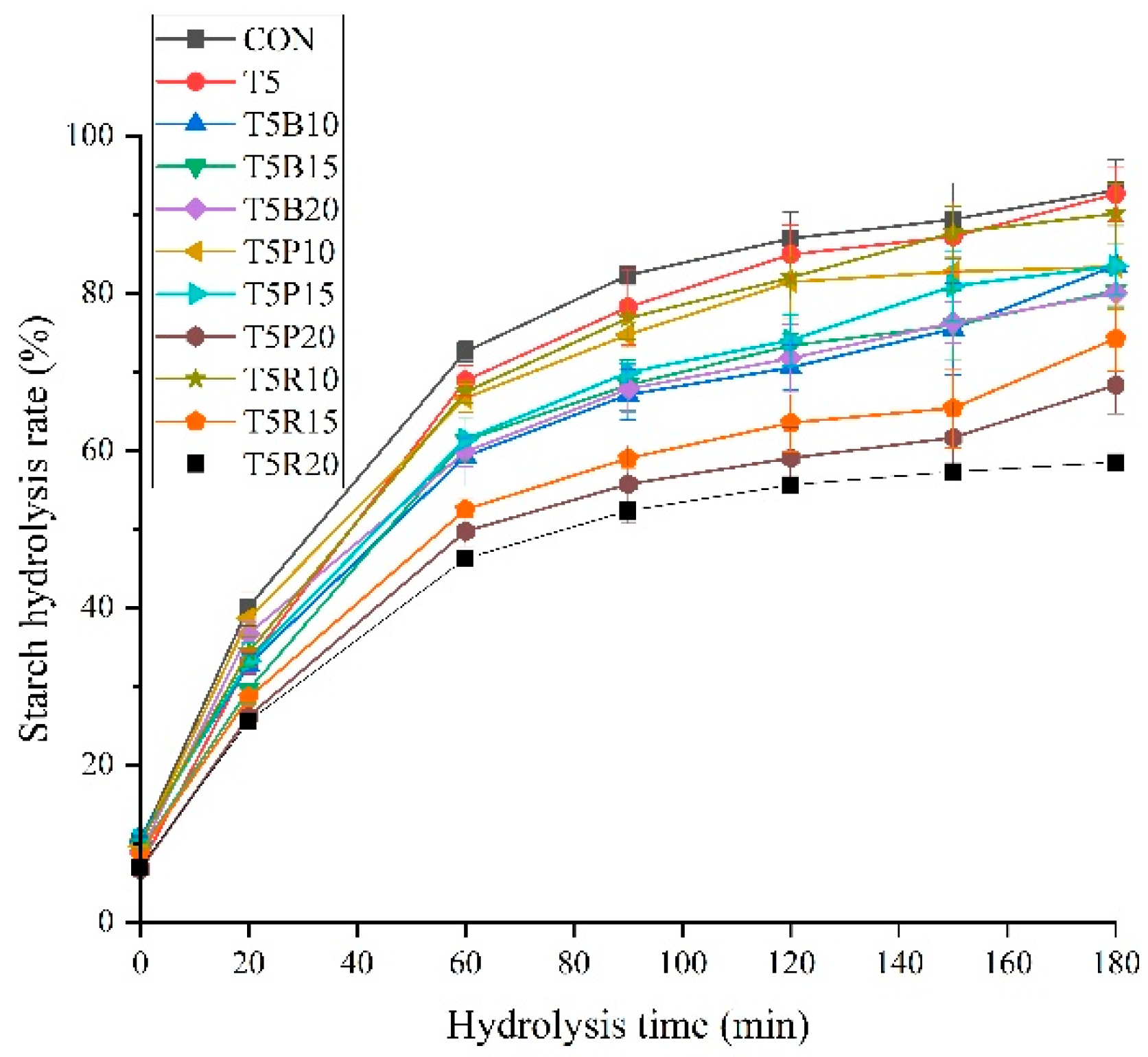
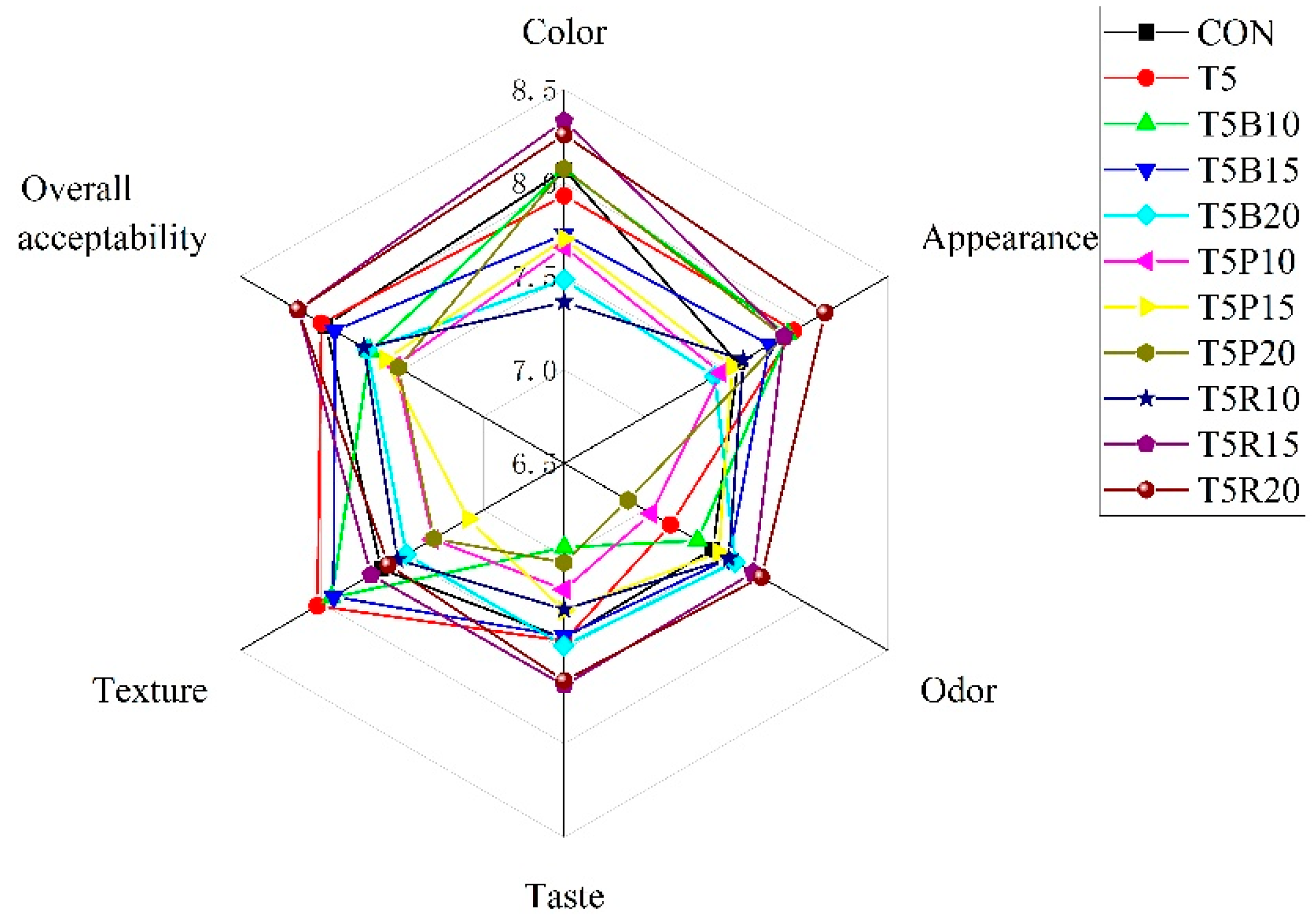
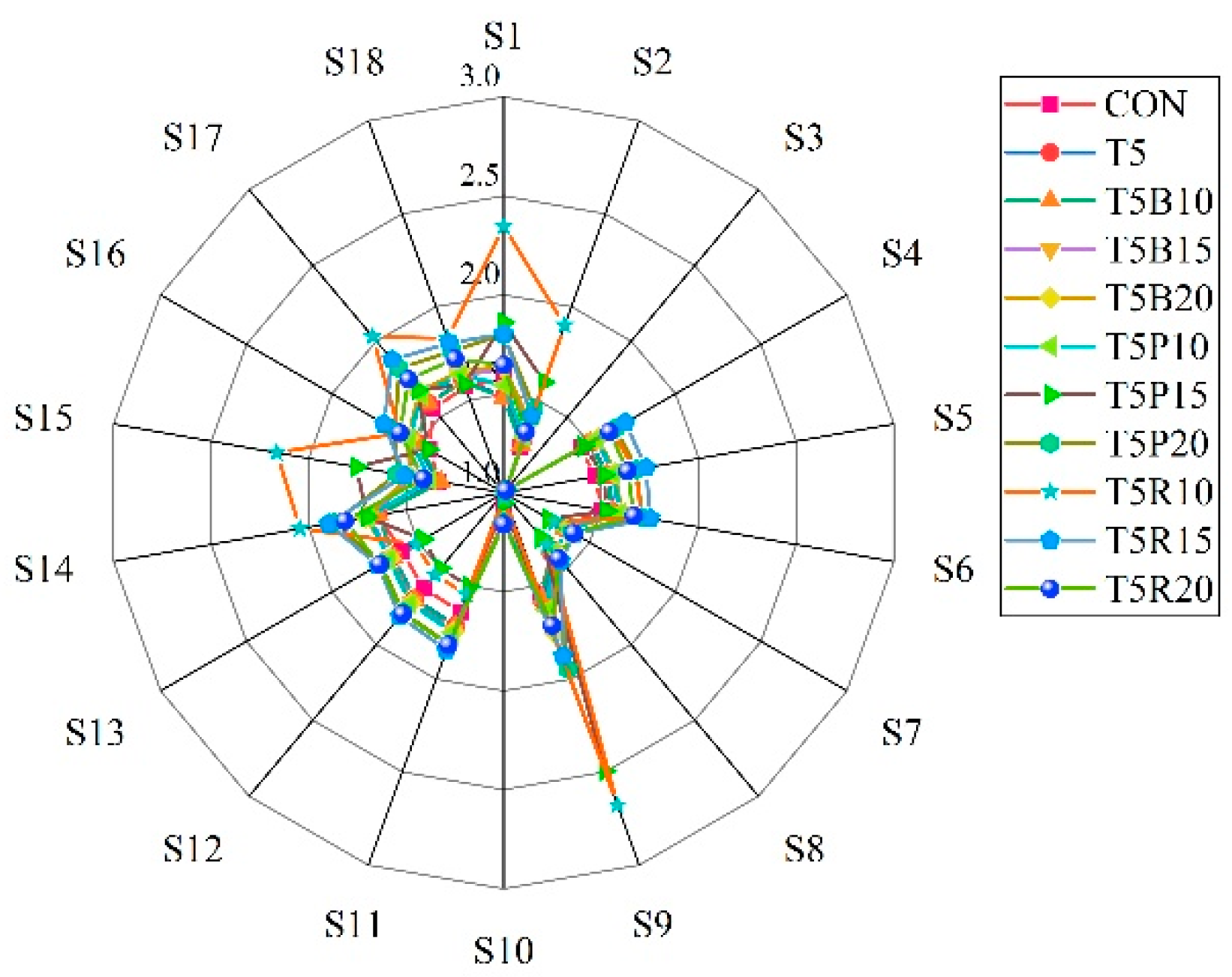
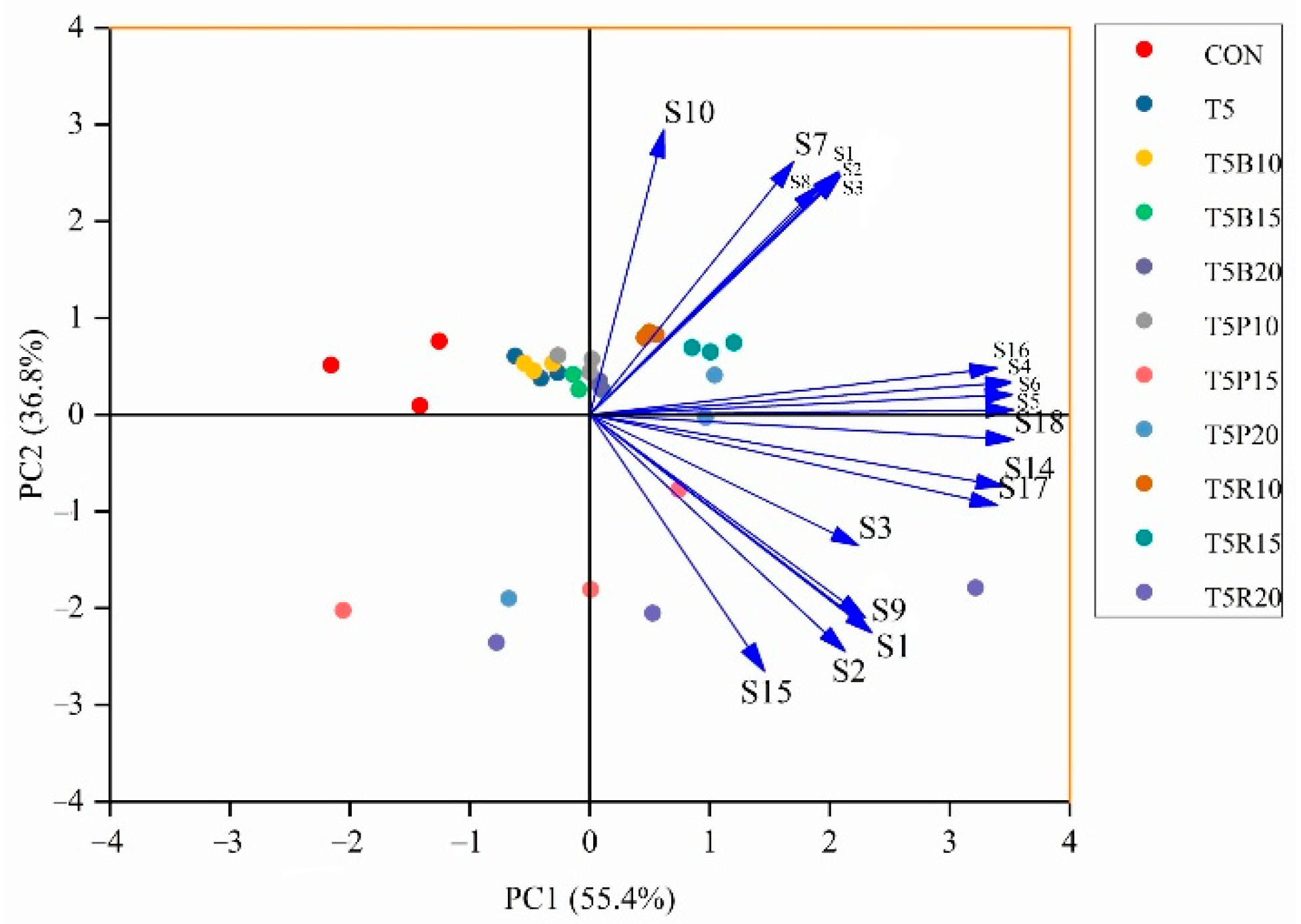
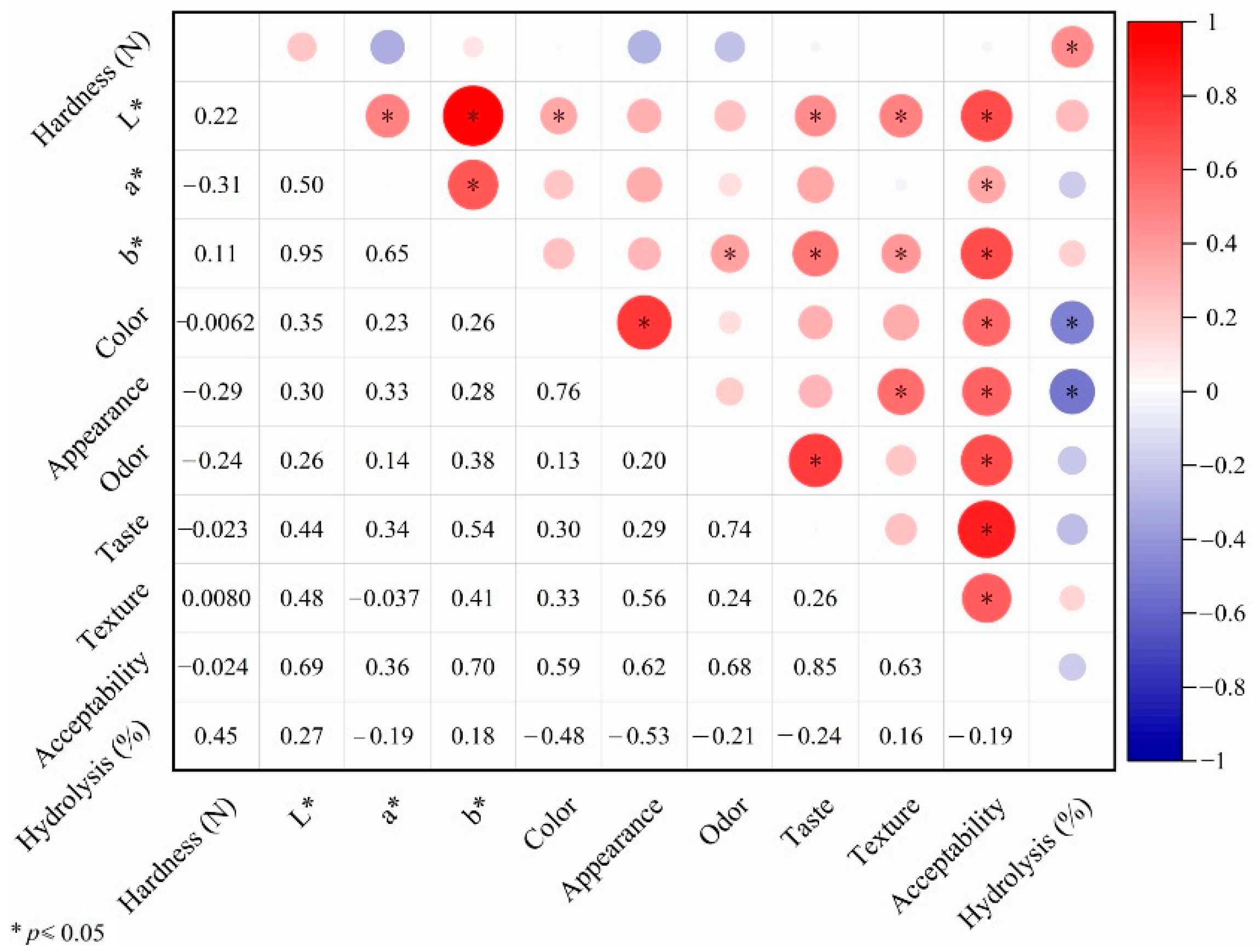
| No. | 1 | 2 | 3 | 4 | 5 | 6 | 7 | 8 | 9 | 10 | 11 |
|---|---|---|---|---|---|---|---|---|---|---|---|
| Cookie (g) | CON | T5 | T5B10 | T5B15 | T5B20 | T5P10 | T5P15 | T5P20 | T5R10 | T5R15 | T5R20 |
| Tricholoma matsutake (g) | 0 | 7.5 | 7.5 | 7.5 | 7.5 | 7.5 | 7.5 | 7.5 | 7.5 | 7.5 | 7.5 |
| Colored rice (g) | 0 | 0 | 15 | 22.5 | 30 | 15 | 22.5 | 30 | 15 | 22.5 | 30 |
| Low-gluten flour (g) | 130 | 122.5 | 107.5 | 100 | 92.5 | 107.5 | 100 | 92.5 | 107.5 | 100 | 92.5 |
| High-gluten flour (g) | 20 | 20 | 20 | 20 | 20 | 20 | 20 | 20 | 20 | 20 | 20 |
| Butter (g) | 120 | 120 | 120 | 120 | 120 | 120 | 120 | 120 | 120 | 120 | 120 |
| Water (g) | 10 | 10 | 10 | 10 | 10 | 10 | 10 | 10 | 10 | 10 | 10 |
| Milk powder (g) | 10 | 10 | 10 | 10 | 10 | 10 | 10 | 10 | 10 | 10 | 10 |
| Sugar (g) | 50 | 50 | 50 | 50 | 50 | 50 | 50 | 50 | 50 | 50 | 50 |
| Salt (g) | 2 | 2 | 2 | 2 | 2 | 2 | 2 | 2 | 2 | 2 | 2 |
| Egg (g) | 25 | 25 | 25 | 25 | 25 | 25 | 25 | 25 | 25 | 25 | 25 |
| No. | 1 | 2 | 3 | 4 | 5 | 6 | 7 | 8 | 9 | 10 | 11 |
|---|---|---|---|---|---|---|---|---|---|---|---|
| Cookie | CON | T5 | T5B10 | T5B15 | T5B20 | T5P10 | T5P15 | T5P20 | T5R10 | T5R15 | T5R20 |
 |  |  |  |  |  |  |  |  |  |  | |
| L* | 74.13 ± 0.89 e | 68.75 ± 1.23 d | 55.79 ± 0.58 b | 55.91 ± 1.37 b | 48.27 ± 1.87 a | 54.89 ± 1.28 b | 47.92 ± 2.37 a | 48.99 ± 1.82 a | 65.29 ± 1.09 c | 65.77 ± 1.01 c | 65.17 ± 0. 70 c |
| a* | 4.75 ± 0.11 abc | 7.01 ± 0.37 de | 3.95 ± 0.24 ab | 3.60 ± 0.86 a | 3.47 ± 0.90 a | 6.05 ± 0.69 cd | 5.07 ± 0.42 bc | 5.36 ± 0.42 bc | 7.92 ± 0.61 e | 8.24 ± 0.63 e | 7.79 ± 0.25 e |
| b* | 35.08 ± 0.84 g | 33.96 ± 0.82 ef | 21.55 ± 0.76 cd | 20.23 ± 0.38 bc | 19.65 ± 0.82 b | 22.31 ± 0.60 d | 16.44 ± 0.53 a | 15.57 ± 0.91 a | 34.75 ± 1.22 ef | 33.47 ± 1.06 e | 33.37 ± 0.10 e |
| Hardness (g) | 1602 ± 147 d | 1194 ± 74 c | 590 ± 20 a | 782 ± 13 a | 1278 ± 31 c | 678 ± 22 a | 762 ± 18 a | 971 ± 12 b | 589 ± 35 a | 619 ± 31 a | 664 ± 12 a |
| No. | Compounds | Abb. | 1 | 2 | 3 | 4 | 5 | 6 | 7 | 8 | 9 | 10 | 11 |
|---|---|---|---|---|---|---|---|---|---|---|---|---|---|
| CON | T5 | T5B10 | T5B15 | T5B20 | T5P10 | T5P15 | T5P20 | T5R10 | T5R15 | T5R20 | |||
| Umami | Glutamic acid | Glu | 9.98 ± 0.14 a | 31.4 ± 0.34 b | 33.4 ± 0.21 b | 29.8 ± 0.61 b | 30.7 ± 0.18 b | 30.5 ± 0.52 b | 33.2 ± 0.10 b | 35.3 ± 1.08 b | 29.5 ± 0.21 b | 32.3 ± 0.13 b | 31.7 ± 1.59 b |
| Aspartic acid | Asp | 5.32 ± 0.58 a | 7.98 ± 0.51 c | 7.81 ± 0.36 c | 7.45 ± 1.19 bc | 7.39 ± 0.67 bc | 7.38 ± 0.35 bc | 8.03 ± 0.51 c | 8.33 ± 0.21 d | 6.87 ± 0.78 b | 7.52 ± 0.61 bc | 7.57 ± 0.10 bc | |
| Subtotal | 15.3 ± 0.64 a | 39.38 ± 0.85 b | 41.21 ± 0.57 bc | 37.25 ± 1.80 b | 38.09 ± 0.81 b | 37.88 ± 0.34 b | 41.23 ± 0.61 bc | 43.63 ± 1.20 c | 36.37 ± 0.80 b | 39.82 ± 0.71 b | 39.27 ± 1.54 b | ||
| Sweet | Serine | Ser | 1.04 ± 0.02 a | 11.9 ± 0.06 b | 11.9 ± 0.01 b | 10.9 ± 0.02 b | 11.2 ± 0.00 b | 10.7 ± 0.07 b | 11.5 ± 0.00 b | 12.0 ± 0.11 b | 10.3 ± 0.06 b | 11.4 ± 0.02 b | 11.3 ± 0.03 b |
| Alanine | Ala | 7.67 ± 0.11 a | 8.45 ± 0.02 b | 8.27 ± 0.08 b | 7.67 ± 0.04 a | 7.35 ± 0.13 a | 7.69 ± 0.11 a | 19.8 ± 0.21 c | 8.89 ± 0.15 b | 18.7 ± 0.10 c | 20.8 ± 0.08 c | 19.4 ± 0.07 c | |
| Threonine | Thr | 6.43 ± 0.08 a | 34.4 ± 0.02 cd | 37.0 ± 0.03 d | 32.1 ± 0.07 c | 31.0 ± 0.16 c | 31.4 ± 0.02 c | 32.1 ± 0.08 c | 37.6 ± 0.01 d | 28.7 ± 0.10 b | 27.5 ± 0.05 b | 29.7 ± 0.00 b | |
| Glycine | Gly | 0.89 ± 0.07 a | 0.15 ± 0.16 a | 0.35 ± 0.01 a | 0.36 ± 0.00 a | 0.18 ± 0.02 a | 0.33 ± 0.01 a | 6.09 ± 0.10 b | 0.22 ± 0.08 a | 6.11 ± 0.02 b | 6.86 ± 0.12 b | 6.27 ± 0.10 b | |
| Subtotal | 16.03 ± 0.30 a | 54.9 ± 0.25 bc | 57.52 ± 0.14 bc | 51.03 ± 0.14 b | 49.73 ± 0.23 b | 50.12 ± 0.20 b | 69.49 ± 0.35 d | 58.71 ± 0.35 bc | 63.81 ± 0.27 c | 66.56 ± 0.25 cd | 66.67 ± 0.20 cd | ||
| Bitter | Isoleucine | Ile | 2.34 ± 0.09 a | 4.95 ± 0.06 b | 5.04 ± 0.01 b | 4.68 ± 0.06 b | 4.63 ± 0.00 b | 4.50 ± 0.06 b | 4.81 ± 0.01 b | 5.34 ± 0.04 b | 4.74 ± 0.02 b | 5.78 ± 0.02 b | 5.35 ± 0.32 b |
| Valine | Val | 4.43 ± 0.20 a | 12.2 ± 0.36 b | 12.3 ± 0.02 b | 10.9 ± 0.24 b | 10.9 ± 0.51 b | 11.0 ± 0.00 b | 11.5 ± 0.21 b | 12.4 ± 0.06 b | 11.3 ± 0.01 b | 13.0 ± 0.05 bc | 12.1 ± 0.01 b | |
| Leucine | Leu | 4.94 ± 1.09 a | 8.67 ± 0.08 b | 9.17 ± 1.06 b | 8.83 ± 0.22 b | 9.18 ± 0.21 b | 9.32 ± 0.02 b | 12.6 ± 0.01 c | 9.67 ± 0.03 b | 12.0 ± 0.00 c | 13.5 ± 0.02 c | 13.4 ± 0.03 c | |
| Arginine | Arg | 1.92 ± 0.36 a | 2.24 ± 0.24 b | 3.17 ± 0.02 b | 2.47 ± 0.24 b | 2.66 ± 0.05 b | 2.66 ± 0.03 b | 2.45 ± 0.00 b | 2.93 ± 0.02 b | 2.91 ± 0.16 b | 2.74 ± 0.08 b | 2.61 ± 0.02 b | |
| Phenylalanine | Phe | 19.6 ± 0.12 b | 21.4 ± 0.22 b | 20.7 ± 0.24 b | 21.6 ± 0.13 b | 22.2 ± 0.01 c | 18.1 ± 0.16 a | 17.4 ± 0.06 a | 18.8 ± 0.16 a | 17.1 ± 0.01 a | 18.7 ± 0.00 a | 16.1 ± 0.19 a | |
| Histidine | His | 39.9 ± 0.14 b | 70.8 ± 0.13 c | 72.3 ± 0.99 cd | 68.0 ± 0.23 c | 79.2 ± 0.04 d | 63.9 ± 0.02 bc | 69.1 ± 1.34 c | 71.1 ± 0.02 c | 8.01 ± 0.04 a | 9.31 ± 0.01 a | 8.69 ± 0.28 a | |
| Methionine | Met | 2.20 ± 0.07 a | 1.22 ± 0.16 a | 1.08 ± 0.30 a | 0.78 ± 0.39 a | 0.88 ± 0.02 a | 1.07 ± 0.03 a | 1.06 ± 0.07 a | 1.29 ± 0.31 a | 1.22 ± 0.25 a | 1.10 ± 0.21 a | 1.41 ± 0.03 a | |
| Subtotal | 75.33 ± 0.52 b | 121.48 ± 0.41 de | 123.76 ± 0.89 de | 117.26 ± 0.51 d | 129.65 ± 0.14 e | 110.55 ± 0.23 c | 118.92 ± 0.14 d | 121.53 ± 0.41 de | 57.28 ± 0.28 a | 64.13 ± 0.64 ab | 59.66 ± 0.99 a | ||
| Tasteless | Tyrosine | Tyr | 50.2 ± 0.09 b | 53.1 ± 0.36 bc | 53.2 ± 0.10 bc | 52.1 ± 0.24 b | 52.6 ± 0.07 b | 54.0 ± 0.19 c | 51.7 ± 0.32 b | 54.4 ± 0.03 c | 12.4 ± 0.14 a | 12.7 ± 0.19 a | 12.2 ± 0.02 a |
| Lysine | Lys | 16.6 ± 2.11 a | 20.7 ± 1.80 c | 21.7 ± 0.36 c | 20.6 ± 0.03 c | 19.5 ± 0.83 bc | 20.0 ± 0.26 c | 18.4 ± 0.11 a | 20.2 ± 0.37 c | 18.6 ± 0.03 a | 21.6 ± 0.32 c | 20.0 ± 0.26 c | |
| Cysteine | Cys | 24.4 ± 1.09 a | 58.0 ± 0.68 d | 58.5 ± 1.14 d | 49.3 ± 0.30 bc | 52.3 ± 0.11 c | 48.2 ± 0.22 bc | 52.5 ± 0.03 c | 58.4 ± 0.18 d | 46.2 ± 0.32 b | 46.1 ± 0.01 b | 46.5 ± 0.03 b | |
| Subtotal | 91.2 ± 2.28 b | 131.8 ± 2.26 d | 133.4 ± 1.91 d | 122.0 ± 0.63 c | 124.4 ± 0.90 c | 122.2 ± 0.64 c | 122.6 ± 0.17 c | 133.0 ± 0.94 d | 77.2 ± 0.69 a | 80.4 ± 0.57 ab | 78.7 ± 0.32 a | ||
| Total | 304.52 ± 1.92 a | 563.32 ± 1.95 de | 578.38 ± 0.16 e | 533.08 ± 0.19 de | 559.34 ± 0.63 d | 519.3 ± 0.82 d | 581.88 ± 0.36 e | 580.74 ± 1.25 e | 392.12 ± 1.96 c | 421.42 ± 0.86 bc | 409.9 ± 0.36 bc | ||
| Sensor | Object Substances for Sensing |
|---|---|
| S1 | Propane, smoke, etc. |
| S2 | Alcohol, smoke, isobutane, formaldehyde, etc. |
| S3 | Hydrogen |
| S4 | Sulfides |
| S5 | Ammonia, amines, etc. |
| S6 | Toluene, acetone, ethanol, hydrogen, etc. |
| S7 | Short-chain alkane combustible gases, etc. |
| S8 | Liquefied gas |
| S9 | Toluene, formaldehyde, benzene, alcohol, acetone, etc. |
| S10 | Hydrogen-containing gases, etc. |
| S11 | Alkanes, carbon monoxide, etc. |
| S12 | Liquefied gas, methane, etc. |
| S13 | Short-chain alkanes, etc. |
| S14 | Methane, gas, smoke, etc. |
| S15 | Ammonia, amines, etc. |
| S16 | Hydrogen sulfide |
| S17 | Hydrogen-containing substances |
| S18 | Aromatic hydrocarbons, aliphatic hydrocarbons, alicyclic hydrocarbons, halogenated hydrocarbons, ethers, esters, diol derivatives, acetonitrile, pyridine, phenol, etc. |
Disclaimer/Publisher’s Note: The statements, opinions and data contained in all publications are solely those of the individual author(s) and contributor(s) and not of MDPI and/or the editor(s). MDPI and/or the editor(s) disclaim responsibility for any injury to people or property resulting from any ideas, methods, instructions or products referred to in the content. |
© 2025 by the authors. Licensee MDPI, Basel, Switzerland. This article is an open access article distributed under the terms and conditions of the Creative Commons Attribution (CC BY) license (https://creativecommons.org/licenses/by/4.0/).
Share and Cite
Qin, Y.; Wang, S.; Chen, H.; Zhuang, Y.; Liu, Q.; Xiao, S.; Brennan, C. Effect of Tricholoma matsutake Powder and Colored Rice Flour on Baking Quality and Volatile Aroma Compound of Cookie. Foods 2025, 14, 2182. https://doi.org/10.3390/foods14132182
Qin Y, Wang S, Chen H, Zhuang Y, Liu Q, Xiao S, Brennan C. Effect of Tricholoma matsutake Powder and Colored Rice Flour on Baking Quality and Volatile Aroma Compound of Cookie. Foods. 2025; 14(13):2182. https://doi.org/10.3390/foods14132182
Chicago/Turabian StyleQin, Yuyue, Shu Wang, Haiyan Chen, Yongliang Zhuang, Qiuming Liu, Shanshan Xiao, and Charles Brennan. 2025. "Effect of Tricholoma matsutake Powder and Colored Rice Flour on Baking Quality and Volatile Aroma Compound of Cookie" Foods 14, no. 13: 2182. https://doi.org/10.3390/foods14132182
APA StyleQin, Y., Wang, S., Chen, H., Zhuang, Y., Liu, Q., Xiao, S., & Brennan, C. (2025). Effect of Tricholoma matsutake Powder and Colored Rice Flour on Baking Quality and Volatile Aroma Compound of Cookie. Foods, 14(13), 2182. https://doi.org/10.3390/foods14132182








